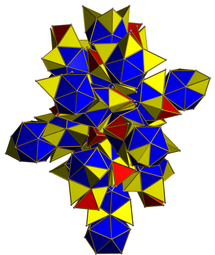Snub disicositetrachoron
| Snub disicositetrachoron | |
|---|---|
 | |
| Rank | 4 |
| Type | Uniform |
| Notation | |
| Bowers style acronym | Sadi |
| Coxeter diagram | s3s4o3o ( |
| Elements | |
| Cells | 24+96 tetrahedra, 24 icosahedra |
| Faces | 96+96+288 triangles |
| Edges | 144+288 |
| Vertices | 96 |
| Vertex figure | Tridiminished icosahedron, edge length 1 |
| Measures (edge length 1) | |
| Circumradius | |
| Hypervolume | |
| Dichoral angles | Tet–3–tet: |
| Ike–3–tet: | |
| Ike–3–ike: 120° | |
| Central density | 1 |
| Number of external pieces | 144 |
| Level of complexity | 10 |
| Related polytopes | |
| Army | Sadi |
| Regiment | Sadi |
| Dual | Quatro-icositetradiminished hexacosichoron |
| Conjugate | Retrosnub disicositetrachoron |
| Abstract & topological properties | |
| Flag count | 5760 |
| Euler characteristic | 0 |
| Orientable | Yes |
| Properties | |
| Symmetry | F4/2, order 576 |
| Convex | Yes |
| Nature | Tame |
The snub disicositetrachoron, or sadi, also commonly called the snub 24-cell or snub demitesseract, is a convex uniform polychoron that consists of 24+96 regular tetrahedra and 24 regular icosahedra. 5 tetrahedra and 3 icosahedra join at each vertex, forming a tridiminished icosahedron as the vertex figure.
It can be constructed by alternating the vertices of a truncated icositetrachoron and then adjusting for equal edge lengths. Alternatively, it can be thought of as a diminishing of the regular hexacosichoron, where 24 vertices corresponding to the vertices of an inscribed icositetrachoron are removed. This is why an alternate valid Bowers style acronym would be idex.
Diminishing by a further set of an inscribed icositetrachoron's vertices of the snub disicositetrachoron yields a bi-icositetradiminished hexacosichoron, diminishing two such sets yields a tri-icositetradiminished hexacosichoron, diminishing three such sets yields a quatro-icositetradiminished hexacosichoron, and diminishing all four of those here remaining subsets results in the hecatonicosachoron. It turns out that all of these pairs from zero to five diminishings result in pairs of dual polychora. In particular, the snub disicositetrachoron's dual is the quatro-icositetradiminished hexacosichoron.
It belongs to a larger family of diminished hexacosichora known as the special cuts, which are a subset of the Blind polytopes.
Gallery[edit | edit source]
-
Wireframe
-
Net
-
Card with cell counts, verf, and cross-sections
Vertex coordinates[edit | edit source]
The vertices of a snub disicositetrachoron of edge length 1, centered at the origin, are given by all even permutations of:
- .
Representations[edit | edit source]
A snub disicositetrachoron has the following Coxeter diagrams:
- s3s4o3o (






 ) (full symmetry)
) (full symmetry) - o4s3s3s (






 ) (B4/2 symmetry, as alternated great rhombated hexadecachoron)
) (B4/2 symmetry, as alternated great rhombated hexadecachoron) - s3s3s *b3s (




 ) (D4+ symmetry, snub demitesseract)
) (D4+ symmetry, snub demitesseract) - fox3ooo3xfo *b3oxf&#zx (D4 subsymmetry)
- oooxxxfffFFF FxfoFfxFofxo xfFFfoFoxxof fFxfoFoxFofx &#zx (K4 subsymmetry)
General variant[edit | edit source]
The snub disicositetrachoron has a general isogonal variant that maintains its full symmetry. This variant uses 24 pyritohedral icosahedra, 24 regular tetrahedra, and 96 triangular pyramids, with three edge lengths. In particular, the variant derived from alternating a uniform truncated icositetrachoron has tetrahedra of size , pyramids with that edge length for base and for sides, and icosahedral variants with for 24 edges and for the other 6.
Variations[edit | edit source]
The snub disicositetrachoron has two isogonal variants with lower symmetry:
- Snub rhombatohexadecachoron - Pyritotesseractic symmetry, has 8 pyritohedral icosahedra, 16 snub tetrahedra, 24 tetragonal disphenoids, and 96 sphenoids
- Snub demitesseract - Chiral demitesseract symmetry, has 3 sets of 8 snub tetrahedra, 24 rhombic disphenoids, and 96 irregular tetrahedra
Related polychora[edit | edit source]
The snub disicositetrachoron's regiment also contains a coincidic scaliform polychoron, the icositetradiminished faceted hexacosichoron.
External links[edit | edit source]
- Bowers, Jonathan. "Category 20: Miscellaneous" (#969).
- Bowers, Jonathan. "Tessic Isogonals".
- Klitzing, Richard. "sadi".
- Quickfur. "The Snub 24-cell".
- Wikipedia contributors. "Snub 24-cell".
- Hi.gher.Space Wiki Contributors. "Snub demitesseract".

































